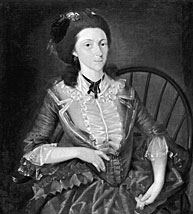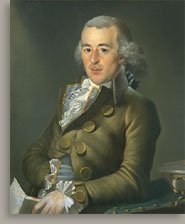 Christian Gullager Christian GullagerStephen Salisbury, 1789 Description Salisbury sits in a relaxed manner, leaning back in a green painted Windsor armchair with his right leg crossing over his left one. His right elbow rests on the arm of the chair and his right hand is on his leg, whereas his left arm is draped along the arched rail of the chair with his left hand grasping the chair's handhold. Gullager painted the hands in considerable detail, carefully delineating the fingernails and highlighting the knuckles and joints of the fingers with brushstrokes of red and white paint on top of the flesh color. The pose creates a diagonal axis from the sitter's head at the upper left to his knee at the lower right of the painting. Salisbury wears a long green coat with large green, gilt-edged buttons. Gullager represented the gold with tan paint and two short brushstrokes of yellow to represent highlights on either side of the buttons. Only one of the buttons of the coat is fastened, thereby revealing the blue-and-yellow striped waistcoat at the waist. The waistcoat is decorated with a double row of silver buttons that are considerably smaller than the ones on the coat. Salisbury wears a white stock, shirt ruffle, and ruffled cuffs; the ruffles are made of a sheer fabric and are trimmed with white ribbon. His black breeches are fastened at the knee with four black buttons and a silver-and-jeweled oval buckle; the black paint of the breeches is showing through the proper right thumb. The top of his white stocking is visible at the lower right corner of the painting. The light brown wall in the background is lightest along the contours of the figure. Light falls from the upper left to the lower right, creating highlights in the face, textiles, buttons, knee buckle, and handhold of the chair at the lower left side of the painting, for example. There are shadows on the proper left side of Salisbury's face, in the folds of the textiles, and below the ruffles of the shirt sleeves. Biography In Worcester Stephen initially rented a small store and boarded with a Mrs. Chandler, but he aspired to a more independent future. He explained to Samuel, "it would be prudent in me to fix upon some place to live upon, for I see no way of ever bettering myself here untill I do have one that I can call my own."5 In May 1771 Stephen purchased the store that he had been renting, along with 150 acres of surrounding farm land at the north end of Main Street.6 The following year he began building a two-storey painted clapboard Georgian mansion that would encompass his shop, storage area, and living quarters.7 Locating a branch of the Salisbury business in Worcester proved to be a good decision. In a broadside that was printed about 1767, the Salisburys advertised the wide assortment, high quality, and inexpensive prices of their goods as well as the convenient location of their store: "PERSONS living in the Country, that go to Boston to buy Goods, may, by purchasing them at their shop at Worcester, save themselves the Trouble and Expence of Transportation."8 In 1775 Samuel Salisbury was forced by the unrest of the American Revolution to close his store in Boston, but the Worcester store continued to operate. Samuel and his family, Martha, and Stephen's unmarried sister Sarah Salisbury (1745–1828) all moved to Worcester and stayed with Stephen.9 Stephen was a member of the Committee of Correspondence in Worcester, although he complained that he did not have time to fulfill the duties of that office.10 In January 1775 he promised "not to purchase any British Goods" and that none of the items for sale in his store had been imported after August 31, 1774.11 In 1784, after peace was reestablished, Stephen's siblings returned to Boston; his mother remained in Worcester until her death in 1792. The latter part of Stephen's life is discussed in the entry for Gilbert Stuart's portrait Stephen Salisbury I. Analysis Salisbury probably based his selection of Gullager as an artist on his brother's recommendation. Samuel Salisbury's wife Elizabeth Sewall Salisbury (Worcester Art Museum) had died unexpectedly on March 25, 1789, and he hired Gullager to paint her likeness in Boston.13 Upon completion of the posthumous portrait, Samuel wrote to his younger brother, "Mr. Gulliker has exceeded my expectation in the picture."14 Shortly thereafter, Stephen paid for Gullager to travel by stagecoach from Boston on May 25, 1789 and to return on June 13.15
Although the portraits of Elizabeth Sewall Salisbury and Elizabeth Salisbury Barrett were sent to their families, Stephen kept his own and his mother's likenesses. Whether Gullager intended it, the portraits of Stephen and Martha (fig. 1) formed a pair and probably hung together in Stephen's home. The two paintings are in the same kit-cat format and cost just over five pounds each, whereas Gullager's portraits of Elizabeth Salisbury and Elizabeth Barrett were bust size and cost about four pounds apiece.20 Both Martha and Stephen are seated in front of a neutral brown wall. Whereas the figures in paired portraits typically turn toward one another, Gullager sometimes painted them facing the same direction. That is the case in the portraits of Martha and Stephen Salisbury as well as those of Offin Boardman and Sarah Boardman. Companion portraits usually represent a husband and wife; however, Gullager's portraits of Stephen and Martha were emblematic of the mother-and-son Salisbury household in which they lived. Martha was not just a visitor in her son's home, she was a dominant presence. When she lived in Boston, her son Samuel complained to his brother:
Samuel found an even more satisfying solution by moving back to Boston at the close of the Revolution and leaving his mother behind in Worcester. Stephen Salisbury remained a bachelor until after his mother's death.
Stephen's brightly colored costume is also characteristic of the clothing worn by Gullager's sitters. For instance, the figure in Major Benjamin Shaw (about 1789, private collection) wears a long red coat over a white silk waistcoat that appears to be embroidered with tiny flowers.24 Gullager's portrait of a Roxbury merchant, Jeremiah Williams (fig. 3), is similar in costume and pose to Stephen Salisbury I. Both men wear their own, powdered hair tied back in a queue. The prominent, gilt-edged buttons of the two men's suits are also alike, although slightly different in color. Both men lean back in relaxed poses with the arm closest to the viewer crossing in front of the body. Whereas Salisbury is completely at rest, Williams is represented among books and papers, indicating a momentary pause from work. Eight years after posing for his portrait, Stephen Salisbury was about to marry Elizabeth Tuckerman (1768–1851) of Boston and hoped that Gullager would paint a likeness of his future bride. Stephen wrote to Elizabeth, "Should Mr. Gullager not wait on you tomorrow, oblige me so much as to desire your Brother Edward to remind him of his Engagements."25 Whether Gullager ever completed the portrait remains uncertain.26 However, the couple did pose in 1798 for companion miniatures to celebrate their marriage; those watercolor-on-ivory portraits were probably painted by the Boston artist William Lovett (1773–1801).27 Notes 2. For Nicholas Salisbury's death, see The Boston Gazette or Weekly Journal, December 13, 1748. 3. For Martha's business, see Martha Salisbury, Account Book, 1753–1773, Salisbury Family Papers, American Antiquarian Society, Worcester, hereafter cited as SFP, AAS, octavo vol. 4. For Stephen Salisbury's education, see Salisbury 1885, 38 and Jenks 1886, 62, 70, 76. 4. Lovell 1876, 2. 5. Stephen Salisbury I, Worcester, to Samuel Salisbury, Boston, June 6, 1770, SFP, AAS, box 2, folder 2. 6. Bond to deed for farm, May 4, 1771, SFP, AAS, box 2, folder 3. 7. In 1929 the Salisbury mansion was moved from its original location to nearby Highland Street; it is owned and operated as a house museum by the Worcester Historical Museum. See Forbes 1930c; Sawyer and Dresser 1946; and Henderson 1982–83. 8. S. & S. Salisbury Hard-ware goods, broadside, Early American Imprints, AAS. 9. Samuel Barrett, Boston, to Stephen Salisbury I, Worcester, May 3, 1775, SFP, AAS, box 3, folder 3. 10. Stephen Salisbury I, Worcester, to Samuel Salisbury, Boston, September 30, 1774, SFP, AAS, box 3, folder 2. See also, Nichols 1925, 54–56. 11. Stephen Salisbury I, Draft of a Declaration to the Worcester Committee, January 24, 1775, SFP, AAS, box 3, folder 3. 12. Nancy A. Goyne, Assistant Registrar, Henry Francis du Pont Winterthur Museum, to Louisa Dresser, September 30, 1966, explains that "the Salisbury chair is an exceptionally nice one." In particular, the carved handhold visible at the bottom left corner of the painting distinguishes the chair from those with more ordinary scroll terminals. For the probable placement of the chair in the mansion, see Meyer 1986a, 34. 13. Samuel Barrett, Boston, to Stephen Salisbury I, Worcester, March 25, 1789, SFP, AAS, box 5, folder 6. 14. Samuel Salisbury, Boston, to Stephen Salisbury, Worcester, April 29, 1789, SFP, AAS, box 5, folder 6. 15. Stephen Salisbury I, Account Book, 1783–1810, SFP, AAS, oversize vol. 1, 286. 16. Samuel Salisbury, Boston, to Stephen Salisbury I, Worcester, May 28, 1789, SFP, AAS, box 5, folder 6. 17. Samuel Salisbury, Boston, to Stephen Salisbury I, Worcester, May 31, 1789, SFP, AAS, box 5, folder 6. 18. Samuel Salisbury, Boston, to Stephen Salisbury I, Worcester, May 31, 1789 and June 16, 1789, SFP, AAS, both box 5, folder 6; and Stephen Salisbury II, "Memoranda of Portraits," SFP, AAS, octavo vol. 62, 37. 19. Samuel Salisbury, Boston, to Stephen Salisbury I, Worcester, September 6, 1789, SFP, AAS, box 5, folder 6. 20. Stephen Salisbury II, Memoranda of Portraits, SFP, AAS, octavo vol. 62, 37 and 49. 21. Samuel Salisbury, Boston, to Stephen Salisbury I, July 12, 1769, SFP, AAS, box 2, folder 1. 22. For painted Windsor chairs, see Fales 1979, 85. Examples of Windsors in Gullager portraits include Elizabeth Coats (Mrs. John Greenleaf) (about 1787, Santa Barbara Museum of Art, Calif.), Mehitable Shaw (Mrs. Benjamin Shaw) (about 1789, private collection), The Reverend George Spafford Woodhull (about 1808, Museum of Fine Arts, Princeton University, Princeton, N.J.), A Boston Gentleman (about 1789, Corcoran Gallery of Art, Washington, D.C.), and The Reverend James Freeman (about 1794, King's Chapel, Boston). 23. For Shaw's portrait, see Troyen 1980, 72–75. I thank Carol Troyen for her help in locating the Shaw portraits. 24. Ibid. 25. Stephen Salisbury I, Worcester, to Elizabeth Tuckerman, Boston, January 9, 1797, SFP, AAS, box 9, folder 2. 26. There is a currently unattributed portrait of Elizabeth Tuckerman Salisbury that, based on the costume, dates from the 1790s in the collection of the Worcester Art Museum. 27. Strickler 1989, 91. The Lovett miniatures were stolen from the Worcester Art Museum in 1944 and are currently unlocated. |


